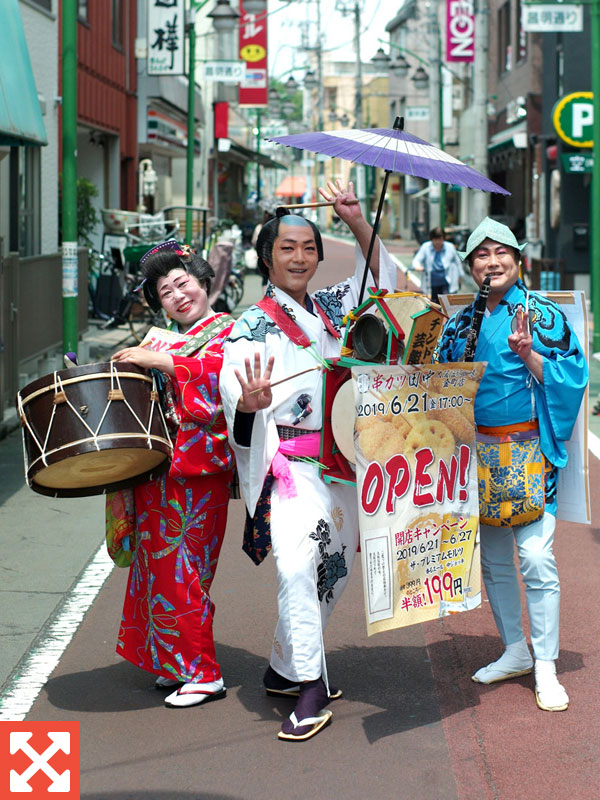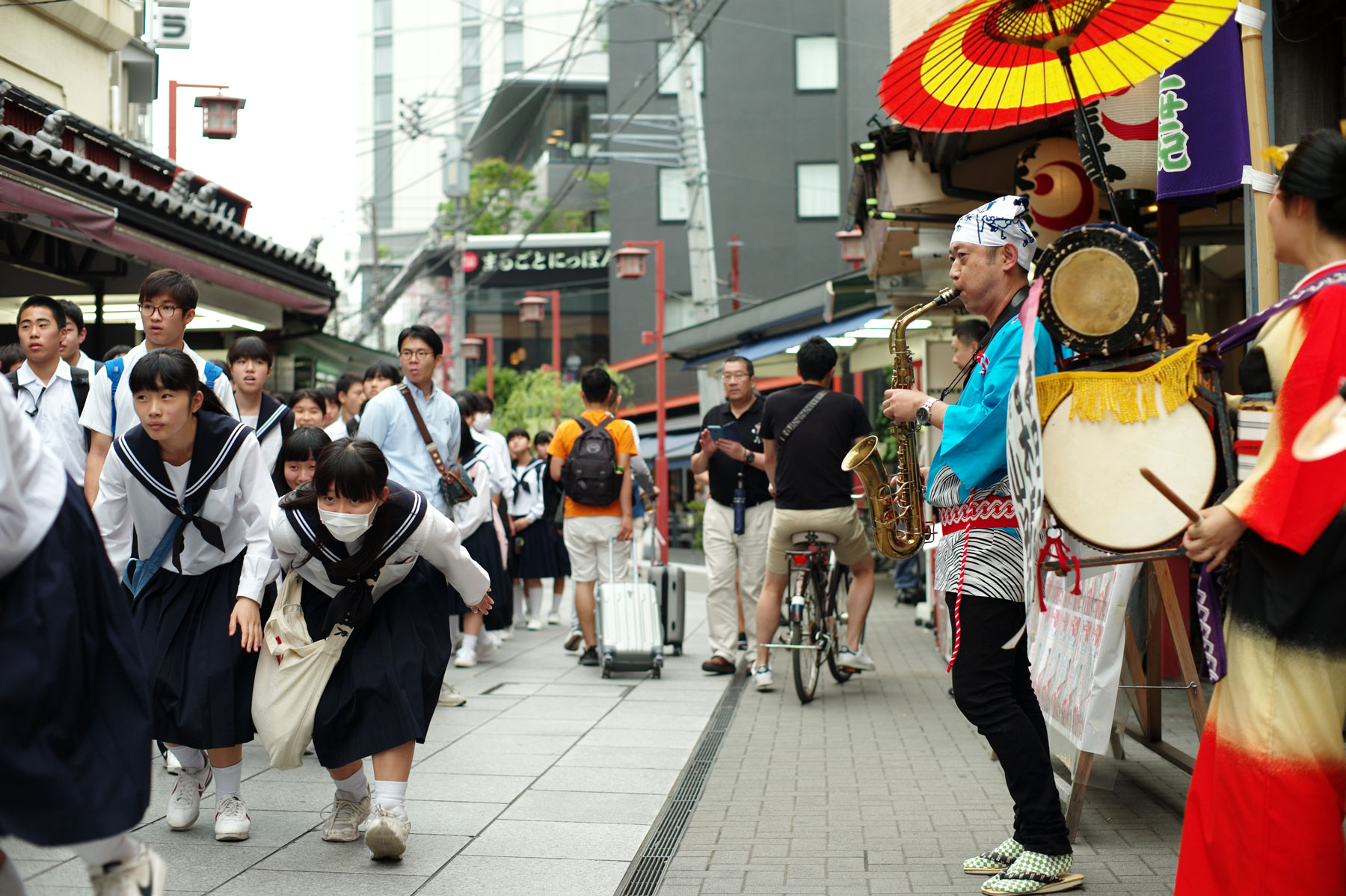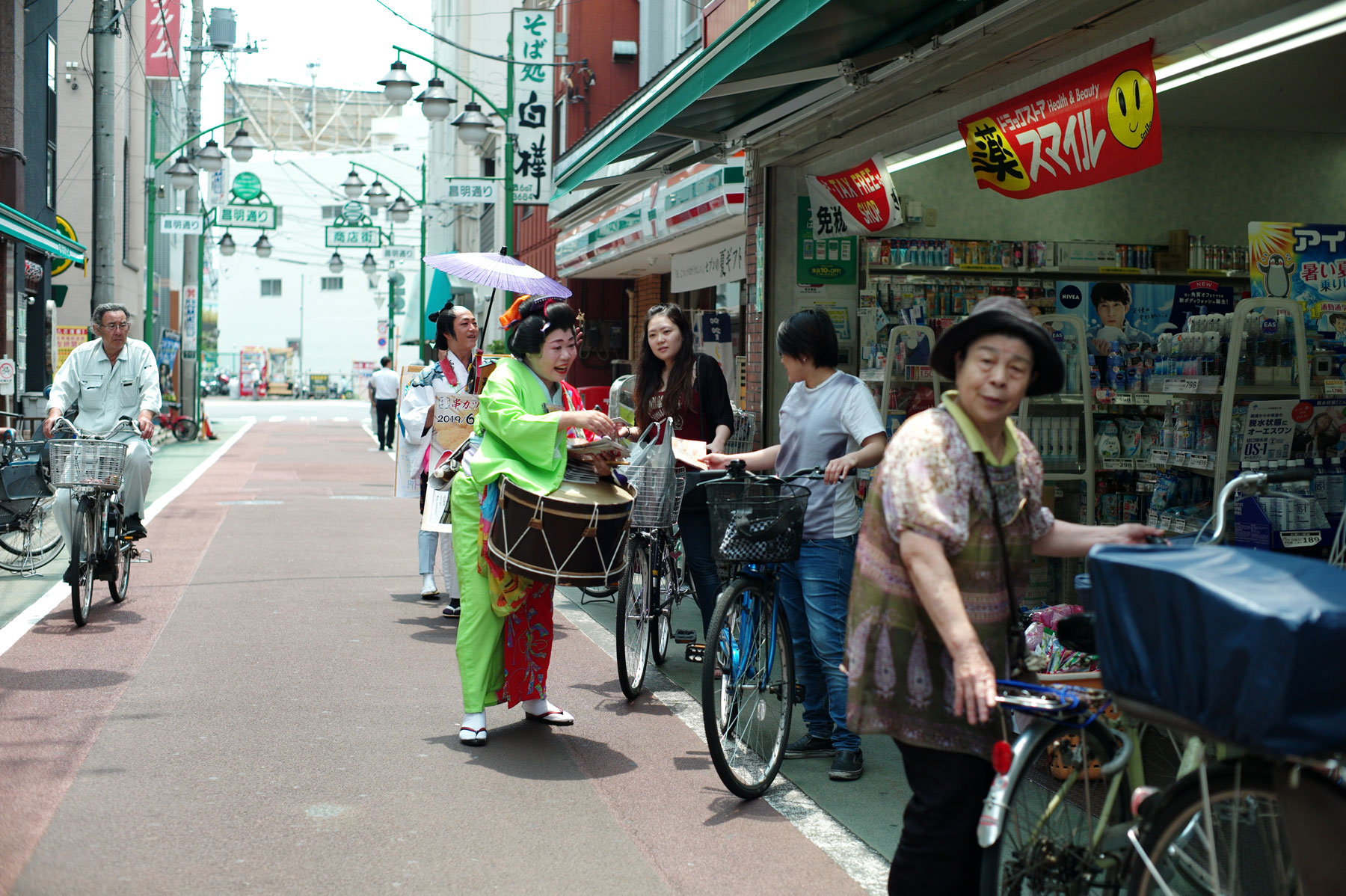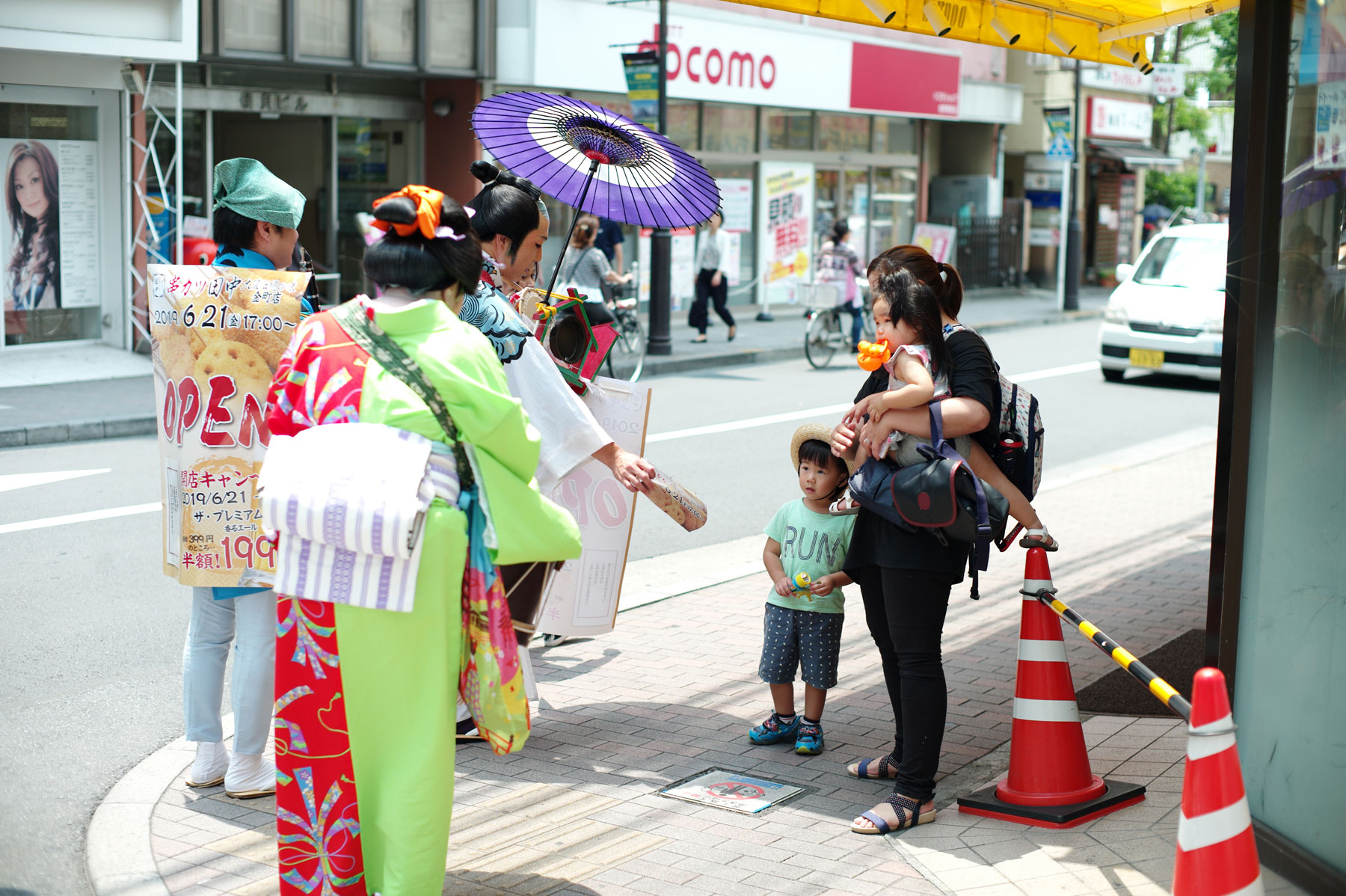CULTURE
Chindonya: The beat goes on
Members of the Chindon Tsukishima Sendensha troupe perform in Asakusa, Tokyo. RYUSEI TAKAHASHI
A dedicated band of performers is fighting to keep a traditional form of advertising relevant
ALEX MARTIN
Staff writer
Flaunting a crisp white kimono embroidered with flowers and a ferocious-looking lion-dog, Hisashi Nagata beats a chindon taiko drum set strapped to his chest as his similarly kimono-clad wife, Mika, chats with curious onlookers while handing them leaflets for a new izakaya (Japanese pub) in Kanamachi, a working-class neighborhood in Tokyo’s eastern Katsushika Ward.
A sense of festivity is injected into the sleepy shopping street as the clarinetist accompanying them plays a rendition of “When The Saints Go Marching In.”
“I haven’t seen a chindonya in ages,” exclaims a retiree in his 70s as he eyes photos of the deep-fried skewers printed on the flier for the Kushikatsu Tanaka restaurant the three-piece troupe is advertising that day.
Young children with their mothers wave their hands at the flamboyant trio, while students from the nearby Tokyo University of Science standing in a line outside a ramen establishment look on collectively in awe. “I’ve heard about chindonya from my parents, but it’s the first time I’ve seen one,” one of them says.
Once a dying profession, Japan’s traditional street advertisers have managed to survive well into the 21st century, their art handed down to successors attracted to their roaming lifestyle and retro charm. And in an age of digital marketing and social media influencers, the localized advertising chindonya troupes bring to urban street corners is being sought by businesses looking to reach a specific demographic.
“Handing out leaflets may sound simple, but whether pedestrians take them depends on discerning what they want to hear — be it the price, menu or operating hours — in a split second,” Mika says. “It’s not a skill you can pick up overnight, it takes years and years of practice.”
Historical origins
Although historically associated with urban centers such as Tokyo and Osaka, these wandering musical troupes can now be found in many cities across the nation, enthralling those drawn to the various facets of a chindonya performance — the music, costumes, speech and swagger — that evolved over the course of nearly two centuries.
Chindonya’s origins are often traced back to 1845, when Amekatsu, an Osaka man and candy vendor, began advertising his products using bells and wooden clappers. He soon started offering his services for theaters looking to lure in customers,
a trend that caught on among other merchants in Osaka.
“While Amekatsu was known for his speech accompanied by bells and woodblocks only, this idea of a sonic proxy advertisement practice inspired others not only in Osaka but also in Tokyo,” Marie Abe writes in her book, “Resonances of Chindonya: Sounding Space and Sociality in Contemporary Japan.”
“In 1886, Tokyo musician Akita Ryukichi combined the idea with a European-style brass band, expanding the scale and instrumentation significantly from Amekatsu’s one-man sonic advertisement performance.”
At the time, chindonya troupes were called hiromeya in Tokyo, a term apparently derived from the name of Akita’s company, and tozaiya in Osaka, for their attention-grabbing cry of “Tozai! Tozai!” which literally translates to “East, west! East, west!”
Abe writes that these two musical influences — traditional Japanese instruments and European-style brass bands — eventually merged over the course of the following decades.
A store opening celebration featuring chindonya in Yamuracho, Yamanashi Prefecture circa 1935. WIKIPEDIA/PUBLIC DOMIAN
While these advertising bands flourished during the late 19th and early 20th centuries, police soon began tightening regulations and the profession was hurt by the arrival of new advertisement mediums such as illuminations and balloons. Many troupes lost members as an increasing number of roles in silent films became available, generally paying better wages. The 1923 Great Kanto Earthquake and the global depression dealt a further blow.
Things began turning around for the scene, however, with the introduction of talkies, or movies with sound, which cost many musicians their jobs and forced them back on the streets. The popularity of motion pictures also led to a decline in traditional theater, leading actors, as well as other performance artists, to turn to street advertising as a source of income.
And while the onset of World War II curtailed chindonya’s work, they bounced back in popularity during the hardscrabble years following the end of the war as black markets popped up and numerous pachinko parlors sprouted across the nation, becoming one of chindonya’s major employers.
As the economy grew and television sets and newspapers became ubiquitous in households throughout the 1970s, demand for the troupes’ brand of advertising began to fall and their numbers, once estimated to count around 2,500 in their heyday, dropped to a few hundred. Overwhelmed by television and newspaper ads and mass-marketing schemes of corporations, chindonya troupes were about to be forgotten in a haze of nostalgia.
Musical heritage
The cultural resurgence of chindonya in the late-20th century may be attributed to the form’s distinct musical heritage.
“A musician named Masami Shinoda produced an album titled ‘Tokyo Chindon,’ which was comprised of performances by a chindon troupe called Hasegawa Sendensha,” says Yuko Hotta, leader of the Tokyo-based Chindon Tsukishima Sendensha troupe.
An alto-saxophonist and composer, Shinoda was a prominent figure in Japan’s underground music scene and was attracted to the hybrid nature of chindon music that combined elements of jazz, klezmer, brass band and Japanese folk. “Tokyo Chindon,” the album he produced and released in 1992 — the same year of his untimely death — is credited for reviving interest in the unique musical style.
“That album ignited something of a chindon boom that attracted many relatively young newcomers to the chindon scene, including my husband,” Hotta says.
Hotta, 49, was a student at the Joshibi College of Art and Design and was an aspiring stage actress when she was introduced to chindonya through an acquaintance she met at a theater group she was a part of. Without thinking too deeply, she visited the home of the late Nidaime (a term in this case referring to the second-generation successor to a stage name) Takinoya Gorohachi, and soon became his apprentice, marching down the streets as a novice.
“Back then, the chindon scene was suffering from a lack of new blood, and even the youngest performers were already in their 50s,” Hotta recalls. “But that also meant many were in the business from their childhood and lived and breathed chindon. They were steeped in its tradition from head to toe, and that fascinated me.”
Rough-spoken and quick-tempered, these old-school chindonya were nevertheless excellent performers, Hotta says, able to stir up emotions with a single drumbeat.
The term chindon is derived from the sounds produced by the chindon taiko (drum), a unique three-in-one instrument that combines two wadaiko (Japanese-style drums) and a gong fixed into a wooden frame, carried by the leader of the troupe.
“Chin” is considered to be the sound of the gong ringing while “don” is the bang of the drums. Hotta says the minimal and most common chindonya setup is a trio, with the chindon taiko player — the leader of the group — typically accompanied by a bass drummer and another player performing a melodic instrument that might include saxophones, trumpets, clarinets and accordions. The repertoire of a chindon group can range from more traditional genres including minyō (Japanese folk songs) and hayashi (festive music) to Japanese and Western pop music, classical music to Dixieland jazz — anything is pretty much game.
There are no fixed rules regarding costumes, as long as they are immediately recognizable. Common outfits include kimono, samurai and princess outfits and even circus clown suits, which Hotta’s husband, saxophonist Hiroki Hotta, used to wear when they first met. The number of chindon performers hired for an occasion can also fluctuate depending on the sponsor’s budget.
“When I began working as a chindonya, we sometimes had gigs involving five or even 10 performers,” she says. While uncommon now, there used to be the hatafuri (flag-waver) carrying advertisement banners and those specifically tasked to hand out flyers, she says. Work mainly involved advertising for stores in shōtengai shopping alleys and pachinko parlors, but with mom-and-pop shops fast disappearing and the tightening of advertising regulations for pachinko shops, business nowadays relies heavily on promoting new chain-restaurant openings and various corporate and community events. A chindonya hired for a day of advertisement will typically work seven hours — a length of time established by tradition — interspersed by short breaks and lunch.
Hotta says her troupe, which she founded in 1997, are often asked to perform at festivals hosted by local communities and municipalities, as well as at caring homes for the elderly and other facilities. She’s been invited overseas as well, playing at the Japan House in London as well as at a cultural exhibition in Ningbo, a city in China’s Zhejiang province.
While Hotta appreciates how her occupation is sometimes perceived as a distinctly Japanese cultural heritage that merits some form of preservation, she thinks that attitude contradicts the essence of chindonya.
“This may be a strange way of putting it, but chindon is for everyday folks and not about sophistication,” Hotta says. “It should be wild, uncivilized, down to earth and, to a certain extent, shrouded in mystery — although that sort of ambiguity may have a hard time surviving in modern society.”
Reflecting her concern, the number of professional chindonya troupes remains relatively small. Hotta estimates the figure at around 100, roughly the same number of performers from around 30 groups that gather for the annual three-day All Japan Chindon Contest held every April in the city of Toyama.
Competitive streak
The largest and most-respected chindon competition in Japan — an event that launched in 1955 — celebrated its 65th contest this year. Mika, Nagata’s wife and part of the Chindon Geinousha troupe the couple founded in 2007, has been a regular participant, achieving first place for three consecutive years between 2015 and 2017. Her group finished second this year.
“We begin preparing from around February, spending a week to 10 days making props and other decorations necessary for the three-minute slots we get,” she says.
The 52-year-old from Japan’s northernmost Aomori Prefecture delved into theater performance after graduating high school, but was sent to Tokyo when she was 22 by her parents who were concerned that their daughter needed a “proper” job. She began working for her uncle’s architectural firm in Koenji, but found herself hanging out in the bars in the area, where she met Hiromi Oba, a chindon performer who goes by the name of Wakame and is author of “Chindon,” a nonfiction book comprised of interviews with veteran chindonya. Oba introduced Mika to people in the chindon community, and she soon experienced her first job handing out flyers.
“After the day was over, I got paid in cash. It wasn’t much, but until then I had never earned money from theater and I thought to myself, ‘This job involves both musical and theatrical aspects, and I even get paid!’”
Mika soon quit the design company she was working for at the time and became an apprentice with Takinoya Gorohachi — the same troupe leader Yuko Hotta worked for. After Takinoya Gorohachi’s death, she apprenticed under Susumu Murasugi, a legendary chindonya who passed away in 2009 and who went by the name Midoriya. He was known for his powerful drumming and ostentatious outfits.
Like Mika, it was by chance that Nagata, 54, became a chindonya.
A graduate of the prestigious Waseda University, Nagata began his career as an employee of the rather stiff-sounding Japan Industrial Safety & Health Association. Despite his white-collar job, Nagata was also playing drums in an amateur rock band, a hobby that continued since his college years.
“One day when I went out for lunch I saw a three-piece chindon troupe performing in front of a pachinko parlor near my office. The saxophonist appeared quite young, and I thought of recruiting him for my band,” Nagata says.
When the trio was taking a break, Nagata gathered his courage and went up to the saxophonist and asked him how he became a chindonya.
“It was supposed to be a friendly way to start a conversation,” he recalls, “but the saxophonist thought I was interested in becoming a chindonya, and told me to return later that afternoon to meet his boss.”
His boss was the late Kozuruya Kotaro, then 68, who invited Nagata that afternoon to perform on a chindon taiko for an impromptu jam session at a neighborhood park. The saxophonist joined and, later, Kozuruya gave Nagata his name card, telling him to call him up.
Curiosity won and, for several years after that, Nagata studied under Kozuruya while working as a chindonya on the weekends. When he was 34, he took a leap and quit his job, devoting himself to chindon.
Polishing the craft
The life of a chindonya isn’t easy. Carrying around and performing instruments, giving advertising speeches and handing out leaflets for seven hours a day — albeit with breaks — wearing heavy makeup and kimono is exhausting, especially when the weather is scorching hot or shivering cold. To save time, chindonya typically put on their outfits at home before heading to designated work sites, making them quite the spectacle on public transportation.
Police regulations also mean chindonya must get the necessary permits to advertise on the streets. When Nagata is commissioned work, the first thing he does is visit a police station to apply for a road-use permit, a process that takes around three days to clear and costs ¥2,100, meaning he can’t accept work at short notice. Still, there’s an insurmountable joy in polishing the craft.
“It requires a complicated mixture of skills and nuance to engage passers-by with your drum beat,” Nagata says. “Some may be feeling irritable from work or feeling down. Our performance should be something positive that empathizes with people, while at the same time arousing their interest in the things we advertise,” he says.
Mika considers her work more akin to a craftsperson or a tradesperson rather than a traditional performing art — at the end of the day a chindonya’s job is to advertise and not about making an artistic statement.
Still, that doesn’t mean professional chindonya performers are closed toward new possibilities. Yuko Hotta recently received the Minatoya Kosome stage name after years of studying rōkyoku — a genre of traditional Japanese narrative singing typically accompanied by a shamisen.
Mika recently performed on stage for a chanbara samurai sword-fighting show, while Nagata will be hosting a special live set involving chindon music on Aug. 24 at the Chito-Shan live house in Arakawa Ward.
“I think we need to experiment with new forms of expression in case we can no longer depend on advertising alone to sustain ourselves,” Mika says.









